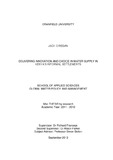JavaScript is disabled for your browser. Some features of this site may not work without it.
| dc.contributor.advisor | Franceys, Richard | |
| dc.contributor.advisor | Parker, Alison | |
| dc.contributor.advisor | Bolton, Simon | |
| dc.contributor.author | O'Regan, Jack | |
| dc.date.accessioned | 2013-08-09T08:42:11Z | |
| dc.date.available | 2013-08-09T08:42:11Z | |
| dc.date.issued | 2012-09 | |
| dc.identifier.uri | http://dspace.lib.cranfield.ac.uk/handle/1826/8026 | |
| dc.description.abstract | Improved access to water and sanitation in the worlds slums were among the key targets in the Millennium Development Goals. In Kenya, water is generally accessed in slum areas by filling 20l jerrycans at standposts and water kiosks and carrying back to households, with residents paying up to nine times more than utility bulk water prices and spending large parts of their day collecting water. The aim of this research was to assess consumers’ response and reaction to a series of water delivery mechanisms designed to offer a range of service levels and prices in accessing water in informal settlements. The current situation of residents’ access to water in seven informal settlements in Nairobi and Kisumu was assessed via household surveys and interviews with water providers, both municipal utilities and private operators, supplemented with observation of local practises. A series of innovative water delivery techniques were then designed to suit the prevailing conditions intending to offer price differences and volumetric purchase options. Follow up surveys were then carried out. This research has found that offering lower or alternative prices for water services in informal settlements is difficult due to challenges posed by vested interests and those interested in maintaining current high prices for water, and applying a difference in price was easiest in areas with already poor access to water or a new water kiosk. However, residents responded positively to the water delivery service, evidenced by a strong desire for this to continue and a willingness to assist operators in applying group purchases and volumetric purchases. Where it was possible to implement a difference in price corresponding to service level, consumers recognised their ability to move between service levels depending on variable income, their immediate demand and a simple choice. | en_UK |
| dc.language.iso | en | en_UK |
| dc.publisher | Cranfield University | en_UK |
| dc.rights | © Cranfield University 2012. All rights reserved. No part of this publication may be reproduced without the written permission of the copyright owner | en_UK |
| dc.title | Delivering innovation and choice in water supply in Kenya's informal settlements | en_UK |
| dc.type | Thesis or dissertation | en_UK |
| dc.type.qualificationlevel | Masters | en_UK |
| dc.type.qualificationname | MSc by Research | en_UK |
